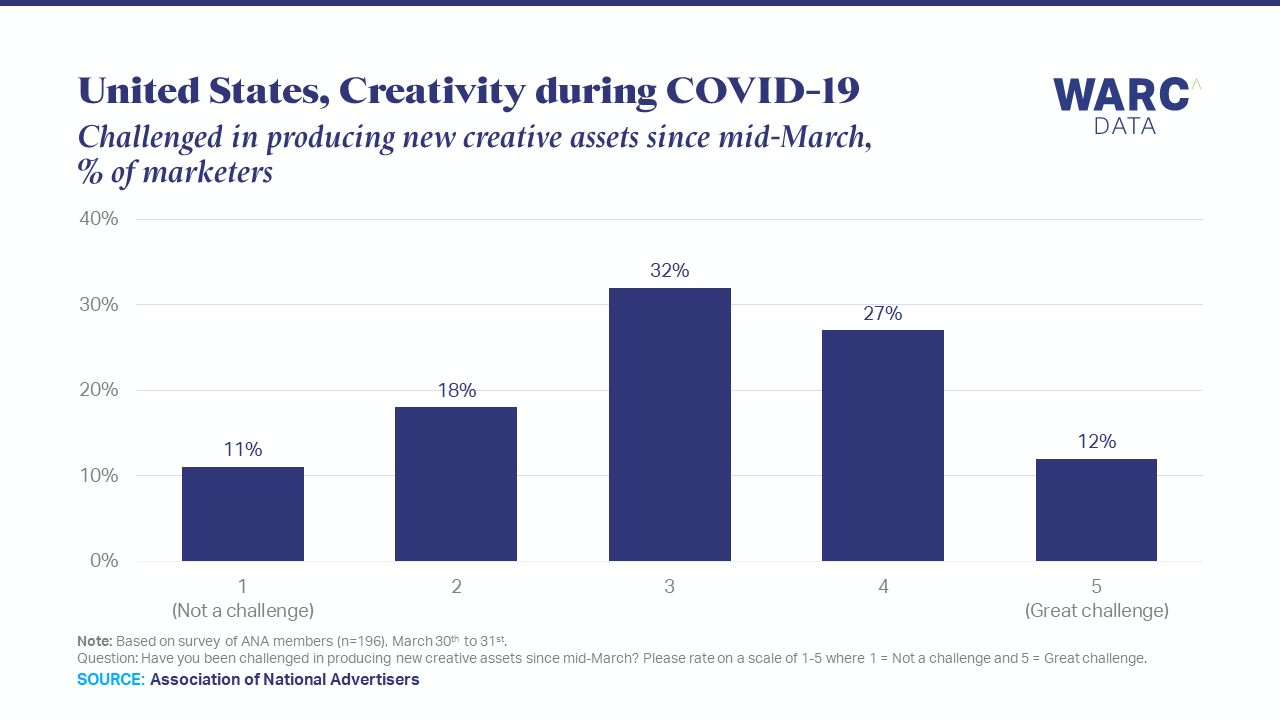Marketers are delivering work that reflects, and responds to, the spread of the coronavirus despite the challenges of fostering creativity under lockdown, a study by the Association of National Advertisers (ANA) has found. WARC’s Stephen Whiteside provides more details.
Marketing in the COVID-19 crisis
This article is part of a special WARC Snapshot focused on enabling brand marketers to re-strategise amid the unprecedented disruption caused by the novel coronavirus outbreak.Nine out of ten marketers have adapted their creative in response to the COVID-19 pandemic – and plan to make similar alterations as the crisis unfolds.
That was the headline insight from a survey by the Association of National Advertisers (ANA), the client-side industry body, that featured 196 companies within its membership, and was conducted on 30–31 March 2020.
The scale of creative evolution
According to the ANA’s poll, since the World Health Organization assigned Coronavirus as a pandemic in mid-March:
- 92% of enterprises had adjusted their marketing creative;
- 46% agreed these changes had been “substantial”;
- 42% had implemented “moderate” alterations;
- 12% suggested any updates were “minimal”.
For those companies that had pursued “substantial” creative modifications, a few illustrative guiding principles were:
- displaying empathy for what stakeholders were facing – and demonstrating the brand was there to help;
- pulling most price- and item-focused messaging;
- crafting new ads from existing footage to ensure cultural relevance;
- scrapping creative executions that are not representative of the current climate;
- acknowledging school closures and social distancing;
- providing essential/useful information;
- avoiding certain lifestyle imagery (e.g. based on travel, spring break, and social gatherings).
Further creative changes are coming
Eighty-nine percent of contributors expect to adjust creative messaging going forwards, too, in reflection of the current climate.
A few ways this might be achieved are:
- showing empathy for the contemporary situation while retaining brand relevance;
- removing content that may be inappropriate, insensitive or tone deaf;
- being more comforting and less promotional;
- adapting to emerging consumer needs on an on-going basis;
- focusing on products that are most pertinent and useful in an increasingly “virtual world”.
In-house teams playing crucial role
The ANA’s numbers left no doubt that in-house agencies and internal teams were playing a critical role in the development of creative assets – a process that may accelerate the pre-COVID trend of brands assuming direct responsibility for varied marketing tasks.

How creative is being made
Despite the difficulties of working from home, and the widespread shutdown of production facilities, only 39% of executives stated that developing new creative assets had been a challenge for their company.

For those businesses struggling to produce new assets, the obstacles included:
- having no access to studios, crews and talent;
- being limited to recuts of existing work, as done remotely by in-house or agency staff;
- lack of time for thoughtful creativity, as the imperative is to “get information out the door”;
- pressure for quick delivery, even though teams are working from home.
When asked how they were producing creative work, some example responses were:
- editing existing film – and filling gaps with stock imagery as required;
- recording new voiceovers and re-mixing music;
- repurposing current assets;
- fast-tracking content without normal testing and vetting procedures;
- tapping user-generated material;
- leveraging animation.

